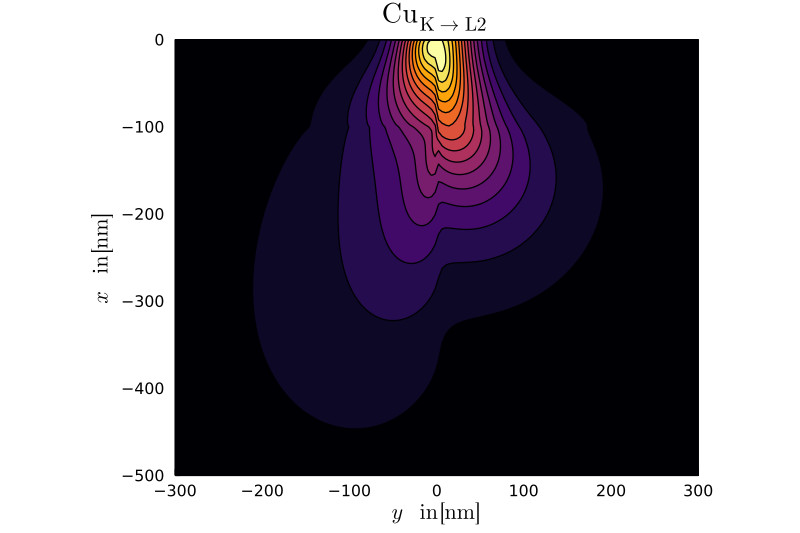Electron Microscopy
Interdiscriplinary Project together with GFE (Gemeinschaftslabor für Elektronenmikroskopie, RWTH Aachen).
Electron Probe Microanalysis
Electron Probe Microanalysis (EPMA) is an imaging technique used for the quantitative analysis of the composition of solid material samples at the micro- to nanometer scale. The sample is excited by a focussed beam of electrons which induces multiple relaxation processes inside the sample. In EPMA the emission of characteristic x-rays is of special focus. If an electron which is induced by the beam strikes a bound electron which occupies an atomic shell of an atom inside the specimen, the bound electron is ejected from its shell and the atom is left with a vacancy. Outer shell electrons fill this vacancy by emitting a quantized x-ray with an energy corresponding to the energy level difference of the originating and the target shell. The energy levels of electron shells are characteristic for a specific atom, hence the energy of the emitted x-ray provides information about the composition of the material sample. In EPMA the intensity of characteristic x-radiation, which are the observed values, is considered in the form of k-ratios.
A detailed introduction to EPMA has been published by the company Thermo Fisher Scientific.
Inverse Problem of Reconstruction
 The determination of material structure and composition forms the inverse problem of reconstruction in EPMA. The crucial ingredients to the inverse problem of reconstruction are the definition of a material model, that maps material parameters to a material composition function (in space) and a accurate model of the physical processes that induce and attenuate the characteristic radiation. Then the reconstruction can be formalized as follows:
The determination of material structure and composition forms the inverse problem of reconstruction in EPMA. The crucial ingredients to the inverse problem of reconstruction are the definition of a material model, that maps material parameters to a material composition function (in space) and a accurate model of the physical processes that induce and attenuate the characteristic radiation. Then the reconstruction can be formalized as follows:
Our model combinatines a model for electron transport in inhomogeneous media based on the radiative transfer equation together with a subsequent model for x-ray generation and attenuation.
The material parametrization plays a essential role in the reconstruction problem. In the one hand, the set of parameters that is reconstructed (layer thicknesses, weight fractions, size and shape of material imperfections) defines the questions posed to the reconstruction algorithm. On the other hand, it alleviates the inherent ill-posed structure of the inverse problem. For a reliable/unambiguous reconstruction result, the inclusion of prior knowledge about the material, which experimenters usually have, is necessary.

- Claus, T., Achuda, G., Richter, S., & Torrilhon, M. (2025),
Subscale inversion of X-ray emission in electron probe microanalysis based on deterministic transport equations. IOP Conf. Ser.: Materi. Sci. Eng. 1324 012005. - Richter, S., Achuda, G., Pinard, P., Claus, T., & Torrilhon, M. (2024),
Inverse Modeling of Heterogeneous Structures in Electron Probe Microanalysis. Microscopy and Microanalysis, 30(4), 729-740. - Claus, T., Achuda, G., Bünger, J., Richter, S., & Torrilhon, M. (2024),
An Adjoint Method for High-Resolution EPMA Based on the Spherical Harmonics (PN) Model of Electron Transport. Journal of Computational and Theoretical Transport, 1-37. - Bünger, J., Richter, S., & Torrilhon, M. (2022),
A Model for Characteristic X-Ray Emission in Electron Probe Microanalysis Based on the (Filtered) Spherical Harmonic (PN) Method for Electron Transport. Microscopy and Microanalysis, 28(2), 454-468. - Bünger, J., Sarna, N., & Torrilhon, M. (2022),
Stable Boundary Conditions and Discretization for PN Equations. Journal of Computational Mathematics. 40 (6). 977-1003. - Claus, T., Bünger, J., & Torrilhon, M. (2021),
A Novel Reconstruction Method to Increase Spatial Resolution in Electron Probe Microanalysis. Mathematical and Computational Applications, 26(3), 51. - Bünger, J., Richter, S., & Torrilhon, M. (2018),
A deterministic model of electron transport for electron probe microanalysis. In IOP Conference Series: Materials Science and Engineering (Vol. 304, No. 1, p. 012004). IOP Publishing. - Mevenkamp, N., Pinard, P. T., Richter, S., & Torrilhon, M. (2016),
On a hyperbolic conservation law of electron transport in solid materials for electron probe microanalysis. Bulletin of the Brazilian Mathematical Society, New Series, 47, 575-588.
- Claus, T. (2021),
Deterministic Reconstruction in Electron Probe Microanalysis using a Flexible Material Parametrization (Master thesis, RWTH Aachen University, Aachen). - Bünger, J. (2021),
Three-dimensional modelling of X-ray emission in electron probe microanalysis based on deterministic transport equations (Doctoral dissertation, Dissertation, RWTH Aachen University, Aachen, veröffentlicht auf dem Publikationsserver der RWTH Aachen University). - Achuda, G. (2020),
Modelling the two-dimensional X-ray Intensity Distribution in Electron Probe Microanalysis (Master thesis, RWTH Aachen University, Aachen). - Claus, T. (2019),
Application of the Adjoint Method in gradient-based Optimization to the M1-Model in EPMA. (Bachelor thesis, RWTH Aachen University, Aachen, veröffentlicht auf dem Publikationsserver der RWTH Aachen University). - Mevenkamp, N. (2016),
Inverse modeling in electron probe microanalysis based on deterministic transport equations. (Master thesis, RWTH Aachen University, Aachen, veröffentlicht auf dem Publikationsserver der RWTH Aachen University).
